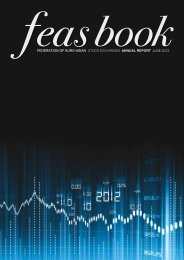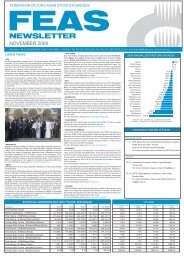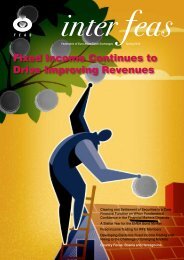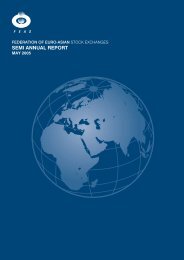JUNE 2013 - FEAS
JUNE 2013 - FEAS
JUNE 2013 - FEAS
You also want an ePaper? Increase the reach of your titles
YUMPU automatically turns print PDFs into web optimized ePapers that Google loves.
FEDERATION OF EURO-ASIAN STOCK EXCHANGES ANNUAL REPORT <strong>JUNE</strong> <strong>2013</strong><br />
AMMAN STOCK EXCHANGE<br />
The ASE has continued in 2012 with its<br />
efforts, aiming at developing the market,<br />
and increasing its efficiency.<br />
Nader Azar<br />
Acting Chief Executive Officer<br />
The Amman Stock Exchange (ASE)<br />
managed to pass the year 2012 with a<br />
stable performance in spite of the unstable<br />
political situation in the surrounding countries,<br />
especially in neighboring Syria. On the<br />
economic level, 2012 wasn’t an easy year for<br />
Jordan as well, due to multiple factors that<br />
weighed on the budget deficit including the<br />
huge influx of Syrians seeking refuge in Jordan,<br />
the Egyptian gas supplies that stopped for a<br />
prolonged period, and the foreign aids that<br />
stalled. However, these economic issues eased<br />
before the end of the year, and the performance<br />
of the ASE was stable as it can be noticed<br />
by the slight decline in the ASE general price<br />
index which went down by 1.88%. In addition,<br />
the ASE retained the confidence of investors<br />
especially foreign investors whose ownership in<br />
the ASE stood at 51.7% at the end of 2012.<br />
On the other hand, the ASE continued with its<br />
efforts in updating the technical infrastructure.<br />
And on the legislative level, the ASE applied<br />
new Listing Securities Directives. These<br />
directives are considered a major achievement<br />
in the year 2012, and according to these<br />
directives, listed companies were distributed on<br />
three different markets instead of two, with the<br />
third market having different trading hours and<br />
the first market having higher fluctuation limits.<br />
The criteria that determine to which market<br />
each company pertains include shareholders<br />
equity, free float of the company, profitability,<br />
company’s capital, number of shareholders,<br />
and others. As for the performance of the ASE<br />
during 2012, the Free Float Weighted Index<br />
went down by 1.88% to close at 1958 points<br />
compared with its 2011 closing of 1995 points.<br />
The trading value reached US$ 2.8 billion and<br />
the number of traded shares reached 2.4 billion<br />
while the number of transactions reached 1<br />
million. In addition, the net of non-Jordanian<br />
investments at the ASE showed an increase of<br />
US$ 53.1 million during the year 2012.<br />
HISTORY AND DEVELOPMENT<br />
The Amman Stock Exchange (ASE) was<br />
established in March 1999 as a non-profit,<br />
private institution with administrative and<br />
financial autonomy. It is authorized to function<br />
as an exchange for the trading of securities.<br />
The Exchange is governed by a seven-member<br />
board of directors. A Chief Executive Officer<br />
oversees day-to-day responsibilities and<br />
reports to the board. The ASE membership is<br />
comprised of Jordan’s 63 brokerage firms.<br />
The history of securities trading in Jordan<br />
traces its origins back to the 1930s. In 1976,<br />
the Amman Financial Market was established<br />
to create a regulated trading market. More<br />
recently, as part of Jordan’s move to upgrade its<br />
capital market, a Securities Law was enacted in<br />
1997 separating the supervisory and legislative<br />
roles from those of exchange operations. As<br />
a result, the Jordan Securities Commission<br />
(JSC) was created in the year 1997, the ASE<br />
and the Securities Depository Center (SDC)<br />
were established in 1999. The JSC supervises<br />
the issuance of and trading in securities and<br />
monitors and regulates the market. The SDC<br />
oversees clearing and settlement and maintains<br />
ownership records.<br />
To provide a transparent and efficient market,<br />
the ASE implemented internationally recognized<br />
directives regarding market divisions and<br />
listing criteria. It also adopted procedures for<br />
improving regulatory effectiveness.<br />
The ASE is charged with:<br />
• Providing companies with means of raising<br />
capital by listing on the ASE,<br />
• Encouraging an active market in listed<br />
securities based on the effective<br />
determination of prices and fair and<br />
transparent trading,<br />
• Providing modern and effective facilities and<br />
equipment for trading, recording the trades<br />
and dissemination of prices,<br />
• Monitoring and regulating trading, in<br />
coordination with the JSC as necessary, to<br />
ensure compliance with the law, a fair market<br />
and investor protection,<br />
• Setting out and enforcing a professional<br />
code of ethics among its member directors<br />
and staff,<br />
• Ensuring the provision of timely and accurate<br />
information of issuers to the market and<br />
disseminating market information to the<br />
public.<br />
On March 26th 2000, the ASE launched an<br />
automated order-driven Electronic Trading<br />
System. The system is in compliance with<br />
international standards and takes into account<br />
the G-30 recommendations. This system also<br />
offers brokers immediate access to stock prices<br />
and orders and enables members to trade<br />
remotely.<br />
In May 2006, the ASE has activated a new<br />
version of the electronic trading system (NSC<br />
V2+), which comes as part of the efforts to<br />
meet the increasing needs of the Jordanian<br />
capital market and in order to raise the capacity<br />
of the current electronic trading system to<br />
accommodate the increase in the daily trading<br />
volume.<br />
On March 22nd 2009, the ASE launched the<br />
new version of the electronic trading system<br />
NSC V900. This project is considered a<br />
quantum leap for the concerned institutions<br />
as the electronic trading system has become<br />
linked with the SDC systems and the JSC new<br />
monitoring systems. The new version will help<br />
develop the trading process at the ASE and<br />
enhance the capacity of the electronic trading<br />
system.<br />
On July 14th 2010, the ASE launched the<br />
Internet Trading service. This service is seen as<br />
a major opportunity for interested investors to<br />
trade in securities regardless of their geographic<br />
location. In addition, the service will help<br />
increase the number of investors at the ASE and<br />
enhance their aptitude to engage in securities<br />
trading.<br />
PAGE 20
















